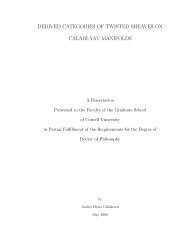FIVE MAJOR RESULTS IN ANALYSIS AND TOPOLOGY Aaron ...
FIVE MAJOR RESULTS IN ANALYSIS AND TOPOLOGY Aaron ...
FIVE MAJOR RESULTS IN ANALYSIS AND TOPOLOGY Aaron ...
Create successful ePaper yourself
Turn your PDF publications into a flip-book with our unique Google optimized e-Paper software.
CHAPTER 4<br />
The Hahn-Banach Theorem<br />
Functional analysis encompasses, not surprisingly, the study of linear spaces and the set<br />
of mappings whose domain is a linear space (including functionals). Three results are abso-<br />
lutely necessary for the development of this field: the Open Mapping and Banach-Steinhaus<br />
theorems which will be discussed in the next chapter, and the Hahn-Banach theorem, which<br />
will be the focus of our current discussion. Before we can state the theorem, a number of<br />
concepts and results need to be developed.<br />
X,<br />
Definition. Let X be a set. If ≤ is a binary relation on X such that, for every x,y,z ∈<br />
(1) x ≤ x,<br />
(2) x ≤ y and y ≤ x implies that x = y, and<br />
(3) x ≤ y and y ≤ z implies that x ≤ z,<br />
then ≤ is called a partial ordering of X. X, when given the relation ≤, is called a partially<br />
ordered set. A chain in X is a sequence of elements x1,...,xn,... ∈ X such that x1 ≤ · · · ≤<br />
xn ≤ · · ·.<br />
Definition. If X is a partially ordered set, then x is called a maximal element in X if,<br />
for each y ∈ X, x ≤ y if, and only if, x = y.<br />
Axiom (Zorn’s Lemma). Let P be a partially ordered set in which every chain has an<br />
upper bound. Then P possesses a maximal element.<br />
23
















